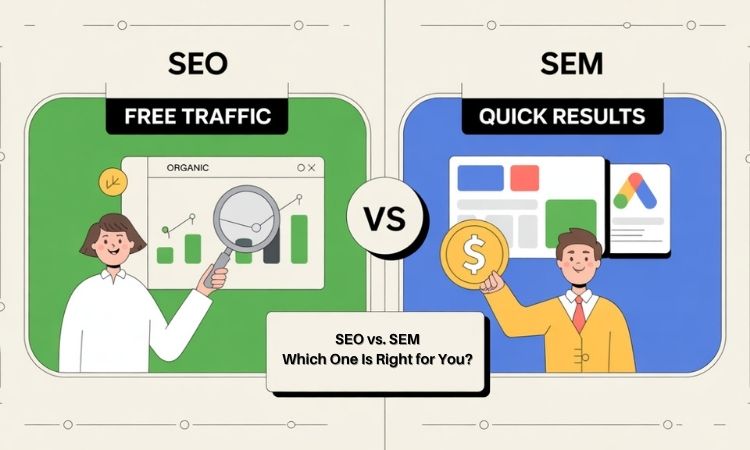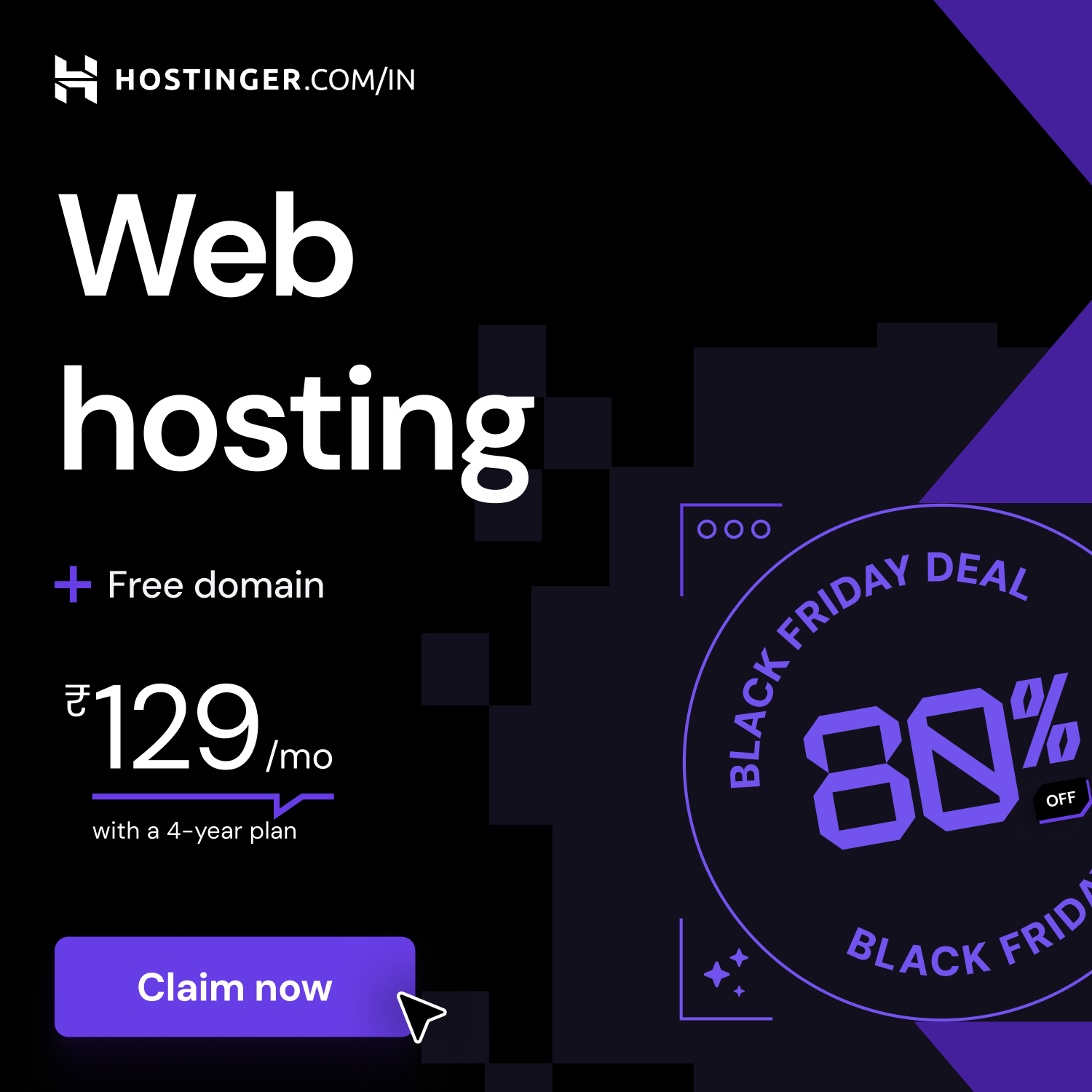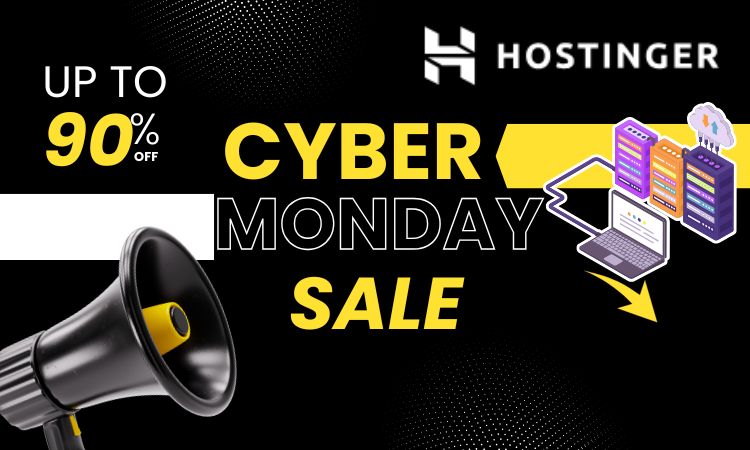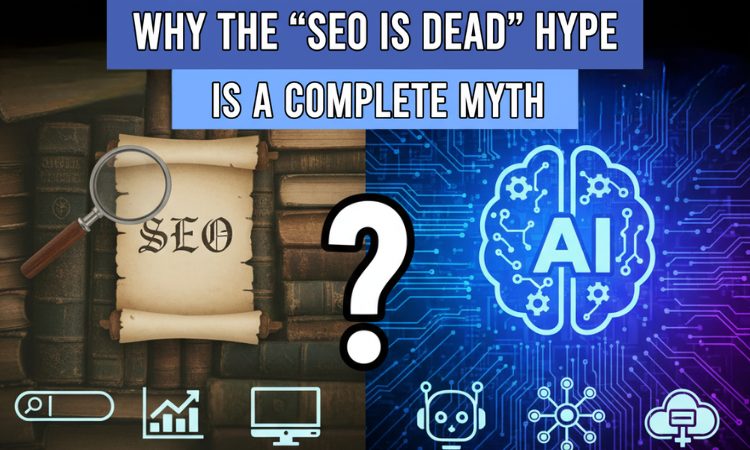Imagine two business owners, both starting an e-commerce website, trying to appear in the first position on Google. One spends hours writing blog posts and optimizing their site – a classic SEO approach – while the other spends a budget on Google Ads to get instant visibility. Both want more eyes on their business, but they’re playing different games. Who will get the most eyeballs? The answer is not that simple. We will have to factor in multiple elements of digital marketing, including keywords, website optimization, bidding, ad strategy, etc.
Therefore, in this blog, we will compare SEO (Search Engine Optimization) and SEM (Search Engine Marketing), side by side, and help you decide when to use each strategy. Whether you’re a business owner, marketing professional, blogger, or an entrepreneur investing in online visibility, understanding “SEO vs SEM” and understanding the difference between SEO and SEM is crucial for your digital marketing strategy.
Table of Contents
ToggleWhat Is SEO (Search Engine Optimization)
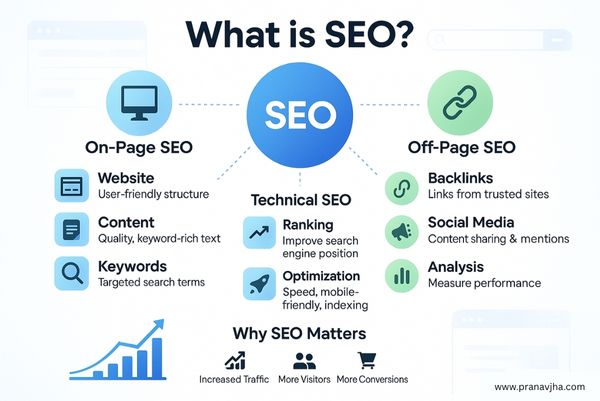
SEO is all about getting organic traffic to your website or blog without paying for clicks. Simply put, SEO involves optimizing your website to rank higher in search engine results pages (SERPs). In practice, that means making your site relevant and authoritative for the queries your customers use.
However, not only user queries, but you will have to focus on website optimization, including on-page/off-page optimization, technical SEO, etc., to make your website or blog ready to rank on search engine result pages (SERPs).
Now, let’s unfold each aspect of SEO to better understand how to rank on search results.
Keyword Research
Keyword research helps you understand what your users are searching for related to your products or services. For example, if you are selling ‘customized jeans for men’, then your users may search terms like ‘customized jeans’, ‘jeans for men’, ‘jeans under 1000 for men’, etc.
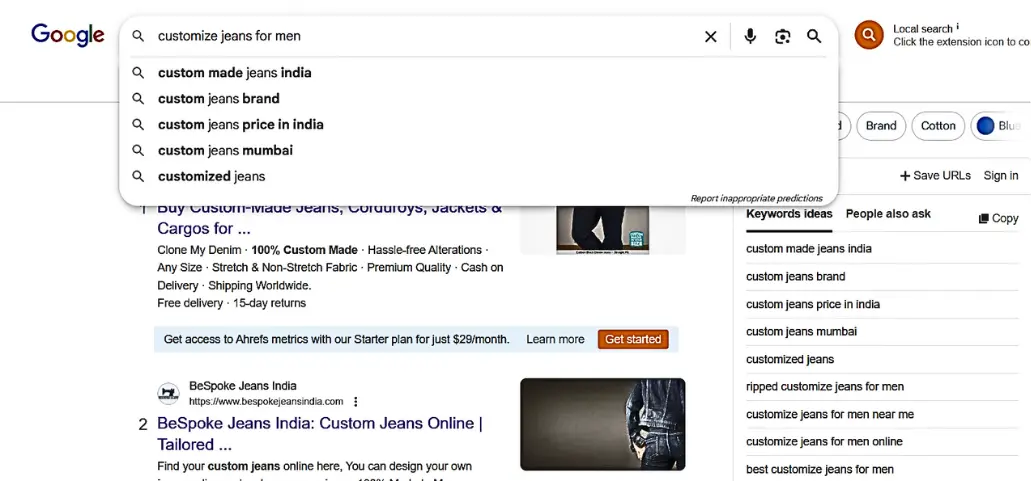
Therefore, it’s always better to know what your users might be searching as it makes it easier for you to work on those keywords and try to rank them on SERPs to earn organic traffic.
To conduct this keyword research, there are multiple keyword research tools available – free and paid – that you can use to start with.
To start your keyword research, just enter a basic term related to your business or website. For example, if you provide digital marketing services to emerging startups in Mumbai, then you may want to enter the keywords ‘digital marketing services in Mumbai’ or ‘digital marketing agencies in Mumbai’, or ‘Best digital marketing consultant in Mumbai’.
Then you need to look for:
- Monthly search volume (how many times users are searching for this particular keyword in a month)
- Keyword difficulty (how hard it is for you to rank for this particular keyword on SERPs)
- Search intent (what users want to do by searching this keyword)
These data points will further help you decide whether you want to work on that particular keyword to rank or not.
On‑Page and Off‑Page SEO
On‑Page SEO covers all optimizations you make on your website. The following are some of the activities you need to do for on-page optimization.
- H1/Title tag: Use your primary keyword in title tag.
- Headers: H2 to H6 headings helps you organize your content and structure it properly.
- Readability: Use tables, bullet points, and clear headings.
- Image Optimization: Use alt tags and file names properly.
Off‑Page SEO refers to efforts outside your site that build authority:
- Brand mentions: Create high-quality content consistently to earn backlinks from other high DA websites and brand mentions organically. You can also purchase backlinks.
- Local listings: Use local directories and forums to mention your brand and website.
- Reviews: Collect genuine customer reviews and respond to them properly to create a positive dialogue.
- Social media: Use social media platforms to build a genuine presence and share original content.
Technical SEO
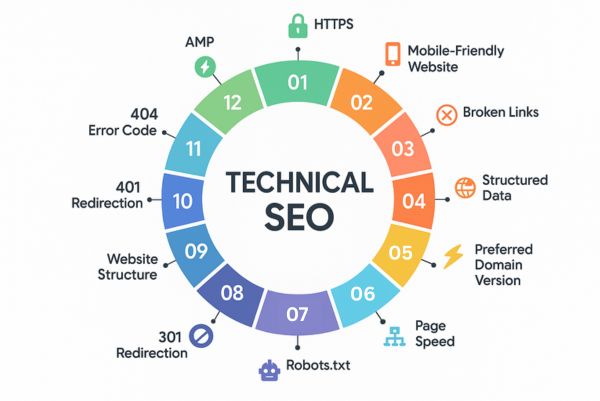
Technical SEO ensures search engines can crawl, index, and render your pages smoothly. The following are some of the key tasks for technical SEO.
- Improving page load speed (minify CSS/JS, use a CDN).
- Implementing HTTPS for security.
- Creating an XML sitemap and a clean URL structure.
- Fixing broken links and proper redirect rules.
- Ensuring a mobile‑friendly, responsive design.
Importance of Content and Backlinking
Google has recently rolled out the March 2025 core update, which aims to improve the quality and relevance of search results. This means Google, being the dominant player in the search engine market share, Google is focusing more on content quality and its relevance to the users’ intent.
On the other hand, backlinks – your website’s link on other authoritative websites on the internet – remain one of the strongest ranking factors: each high‑authority link acts like a “vote” for your content’s relevance.
Tools Used For SEO
The following three SEO tools are the utmost requirements for SEO experts to conduct daily tasks of ranking any website on SERPs.
- GA4: Learn more about your website’s key metrics like CTA, CPC, etc.
- Google Search Console: spot indexing errors and view actual search queries.
- Ahrefs / SEMrush: in‑depth keyword research, backlink audits, and competitor analysis.
- PageSpeed Insights / GTmetrix: identify performance bottlenecks for technical fixes.
Investing in SEO means up‑front content creation and optimization work, but once pages rank, you earn “free” traffic indefinitely. Over time, organic visitors trust your brand more than paid ads, improving both click‑through and conversion rates, making SEO one of the most cost‑effective channels in the long run.
What Is SEM? (Search Engine Marketing)
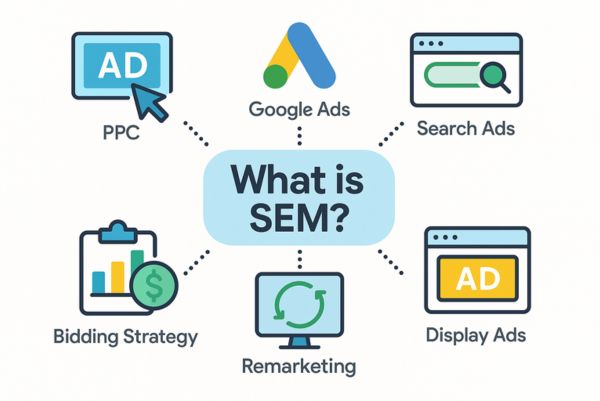
SEM (often used interchangeably with “paid search”) involves paying for ad placement in search engine results. You bid on keywords; if your bid (and ad quality) ranks high enough, your ad appears above or beside the organic listings.
Let’s decode the PPC model and try to understand each aspect of SEM in detail.
Decoding the PPC Model
1. Keyword Research
An SEM campaign always begins with proper keyword research, Just like it does in SEO. Firstly, you need to identify the exact search terms or keywords your target audience use when they search for your website or related products/services.
Start with tools like Google Keyword Planner, SEMrush, or Ahrefs to gather data on:
- Search volume: Know how many people are searching the keyword per month. High volume means high chances of getting more clicks to your website, but with higher competition to rank on that keyword.
- Keyword intent: Prioritize “commercial” or “transactional” intent keywords (e.g., “buy wireless earbuds online”) over purely informational ones (“how wireless earbuds work”).
- Competition and CPC estimates: SEM tools show an estimated cost‑per‑click (CPC) range. If a keyword’s CPC is prohibitively high, consider long‑tail variations that still convert but cost less.
- Relevance: Always choose keywords tightly aligned to your product or service page. Irrelevant keywords may get clicks, but kill your Quality Score and ROI.
2. Bidding
In SEM, your bid determines how much you’re willing to pay for each click. A smart bidding strategy balances cost with performance:
- Manual CPC: You set a maximum bid for each keyword. This gives you granular control but requires constant monitoring.
- Maximize Conversions: This strategy automatically sets bids to get the most conversions possible within your daily budget. It’s ideal when you want fast results and don’t yet have enough conversion data to set a target CPA. It prioritizes volume over efficiency, making it great for short-term goals or campaigns with broad appeal.
- Target CPA (Cost‑Per‑Acquisition): You tell Google the average you’d like to pay for a conversion. The system dynamically sets bids to hit that goal, ideal for lead‑gen campaigns.
- Target ROAS (Return on Ad Spend): Specify the revenue-to-spend ratio you aim for, and Google adjusts bids to maximize revenue within that framework.
Whichever strategy you choose, monitor bid adjustments for devices, locations, or times of day. For instance, if mobile users convert 30% better than desktop users, you might increase your mobile bid adjustment by +20%
3. Audience Targeting
Unlike SEO’s broad keyword reach, SEM lets you laser‑focus on the exact people most likely to convert:
- Geographic targeting: Narrow your ads to specific cities, states, or radii around your store. A café in Bangalore, for example, might exclude audiences outside a 10 km radius.
- Demographics: Target by age, gender, household income, or parental status—useful for products with distinct buyer profiles.
- In‑market & affinity audiences: Google classifies users actively researching (“in‑market”) or closely interested (“affinity”) in categories like “fitness enthusiasts” or “luxury shoppers.” Layer these onto your keyword targeting to reach high‑intent segments.
- Remarketing lists for search ads (RLSA): Re‑engage visitors who’ve already been to your site by bidding higher on searches they perform later, nudging them toward conversion.
By combining keyword intent with audience data, you only pay to show your ad to people who both need your offering and are ready to act.
4. Ad Creation
Your ad copy must be clear, compelling, and relevant to the search query. Best practices include:
- Headlines: Incorporate your primary keyword in at least one headline. Use power words (e.g., “Free Shipping,” “Limited Offer”) to grab attention.
- Description lines: Expand on your headline promise. Highlight benefits (“Lasts 10 hrs on a single charge”) or unique selling points (“Made in India – 1‑Year Warranty”).
- Display URL: Customize the path fields to include keyword‑rich text (e.g., example.com/earbuds/2000).
- Strong call‑to‑action (CTA): End with a clear directive like “Shop Now,” “Book Free Demo,” or “Get Instant Quote.”
Also, keep in mind character limits (typically 30 characters per headline, 90 per description) and craft multiple ad variations to A/B test which messaging resonates best.
5. Ad Assets
Ad assets expand your ad with extra links and information, boosting visibility and CTR:
- Sitelink extensions: Link to specific pages (e.g., “Best Sellers,” “Customer Reviews,” “Today’s Deals”).
- Callout extensions: Short snippets like “24/7 Support,” “Easy Returns,” “No Hidden Fees.”
- Structured snippet extensions: Showcase product categories or services under headers like “Models:” or “Services:.”
- Call extensions: Add a clickable phone number—essential for mobile users.
- Location extensions: Display your address and Google Maps pin, great for brick‑and‑mortar stores.
- Price extensions: List product or service pricing tiers directly in your ad.
Common Platforms: Google Ads & Bing Ads
Google Ads is by far the largest, reaching over 90% of global searchers.
Microsoft Advertising (Bing Ads) often delivers lower CPCs and can be a cost‑effective secondary channel, especially for B2B audiences.
Short‑Term Strategy: Instant Visibility & Lead Generation
SEM can drive traffic within hours of campaign launch. It’s ideal for:
- New product launches (put your offering at the top on day one).
- Limited‑time promotions (flash sales, seasonal deals).
- Testing market demand for new services or markets.
Set daily or lifetime budgets to cap spending.
Use geo‑targeting, device scheduling, and ad‑runtime controls to focus spend on your highest‑value audience segments
Metrics Used:
- CPC (Cost Per Click): average amount you pay per click—lower CPCs mean more clicks for your budget.
- CTR (Click‑Through Rate): clicks ÷ impressions. A high CTR indicates your ad copy and relevance are resonating.
- Quality Score: Google’s rating of your ad’s relevance, landing page experience, and expected CTR; higher scores reduce your CPC.
SEO vs. SEM: Key Differences at a Glance
| Aspect | SEO | SEM |
|---|---|---|
| Definition | Ranking higher in search results organically, without paying for placement. | Paid search marketing: bidding on keywords so your ad appears on SERPs. |
| Cost | No cost per click, but requires investment in content, optimization, and tools. | You pay for each click/impression (PPC); it requires an ongoing ad budget. |
| Speed of Result | Slow burn: typically months to see significant ranking gains. | Fast: ads can go live and drive traffic immediately. |
| Longevity | Long-term: once ranked, traffic can last for months or years with upkeep. | Short-term: traffic lasts only while ads run; stops when the budget ends. |
| Targeting | Broad: mainly keyword-based and content relevance; less granular. | Precise: demographic, location, time, device, and keyword-level targeting. |
| CTR | Typically, higher CTR for organic listings (users often trust them more). | Generally lower CTR (ads are less clicked than organic, per studies). |
| ROI | Higher ROI long-term: upfront effort pays off over time (brand trust, free traffic). | ROI can be high short-term: immediate conversions, but ROI ends when spending stops. |
| Skills/Tools | Requires SEO skills (keyword research, content creation, site optimization); tools like Google Search Console, Ahrefs, SEMrush. | Requires SEM skills (ad bidding, copywriting, analytics); platforms Google Ads/Bing Ads, plus tracking tools (Analytics). |
When Should You Use SEO?
SEO strategies are perfect if you’re playing the long game and want cost-effective, sustainable growth.
- Tight budget? SEO doesn’t charge per click – ideal for consultants, bloggers, or startups with limited funds and a longer vision and higher patience level.
- Building brand authority? If you want to boost trust organically and position your website/brand as a credible source, then SEO is for you.
- Content-first strategy? If you can invest in blogs, guides, or product pages, SEO helps turn that into steady traffic.
- High CPC niche? In industries with expensive ads (like finance or law), SEO offers a more scalable path.
- Credibility matters? Users trust organic results. Brands like TCS rank high and rarely rely on ads.
- You want compounding growth? SEO delivers traffic that builds and lasts—especially for e-commerce and content sites.
When Should You Use SEM?
Choose SEM when speed, targeting, and immediate ROI are top priorities.
- Need instant traffic? SEM gets you on page one instantly – ideal for launches or promos.
- Targeting specific users? SEM lets you filter by location, interests, income, and more.
- Short-term campaigns? Set a fixed budget and schedule for seasonal or time-bound goals.
- Want to test fast? Quickly validate keywords, offers, or messaging, then refine SEO accordingly.
- Launching a new site? Use SEM as a bridge until your SEO gains traction.
- Need quick ROI? SEM provides detailed performance data to justify spend and scale what works.
Can SEO and SEM Work Together?
Absolutely – they complement each other. Many SEO experts and brand managers use both as part of an integrated strategy. Here’s how they can overlap:
- Keyword insights: Run SEM campaigns to identify high-converting keywords, then target those organically through SEO content. For instance, if a certain phrase has a great conversion rate in ads, you might write a blog or landing page around it for SEO.
- Maximizing SERP real estate: When you appear in both organic results and paid ads for the same query, you dominate the search results page. This increases brand exposure and pushes competitors further down.
- Brand awareness + credibility: Use SEM for broad awareness (headlines and ads) while SEO builds trust (in-depth content, reviews). A potential customer sees both and learns more about you.
- Flexible budgeting: In lean months, focus on SEO for steady traffic; in growth spurts or promotions, dial up SEM. This balance helps optimize spend.
- Data-driven improvement: SEM campaigns generate data quickly (which ads work, which keywords convert). Those insights can inform your SEO strategy, content topics, and site improvements.
Final Verdict: SEO Vs SEM
There’s no one-size-fits-all answer. Your choice depends on goals, timeline, and budget. If you’re looking for long-term growth and can invest in quality content, put your energy into SEO. It builds lasting value. An SEO expert will tell you it’s about patience and consistency. Over time, your SEO efforts compound and generate sustainable returns. But if you need immediate visibility or are running a short-term campaign, SEM is a better choice.. It’s like turning on a faucet of traffic. But remember, it’s temporary – the flow stops when the money runs out.
